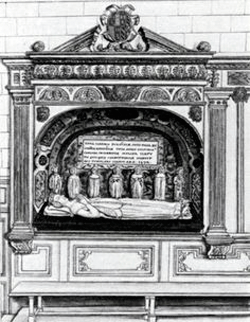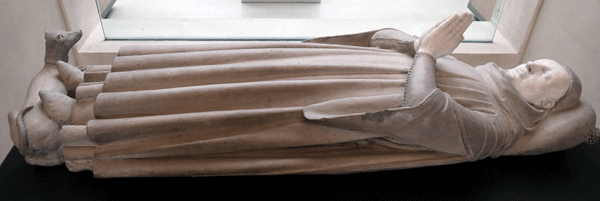PARIS
I have arranged the monuments in more or less datal order but there is an alphabetical list of names immediately below; in order of the first name. They are all to be found in the French Sculpture section of the museum in several adjoining rooms. These works are taken from often demolished churches, mainly in Paris. Often only the effigy - and sometimes only the bust - remains, the rest of the monument having being destroyed. We can thank enlightened men - such as Alexandre Lenoir - for recognizing these monuments as works of art and of historical value, and note merely reminders of a feudal past, and hence saving them for us. Unfortunately the lighting in the Louvre can cause photographic problems at times.
Charles IV (The Fair) Charles V (The Wise) Charles de Maigny Duke Charles de La Vieuville Charlotte-Catherine de La Tremoville Chértienne Leclerk Dominique de Vic Gasparde de la Chatre
Guillaume du Vair Guillaume Froelich Hélène de Commynes Henry II Henry Chabot, Duke of Rohan Duke Henry I de Longuevill Jacques-Auguste de Thou Jacques de Souvré Jean d'Alesse
Jean Casse Jean de Dormans Jean III d'Humières Jeanne de Bosse Jeanne d'Évreux Jeanne de France Louis de Poucher Madeleine Marchand Madeleine of Savoie Marguerite Valon
Marie de Barbançon Marie [Bouhier] Nicholas le Jay Phillippe Chabon Phillippe de Morvilliers Phillippe, Count of Évreux & King of Navarre Pierre d'Évreux-Navarre, Count of Mortain
Philippe de Commynes Philippe Pot Renaud de Dormans Cardinal René de Birague Renée d'Orleans-Longueville Robine Le Gendre Unknown Child Valentine Balbiani William of Chanac
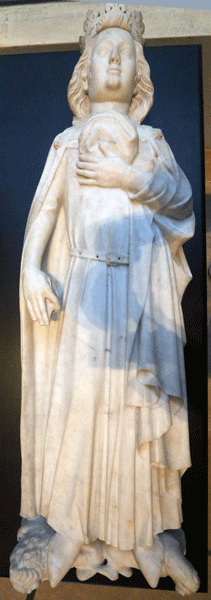 |
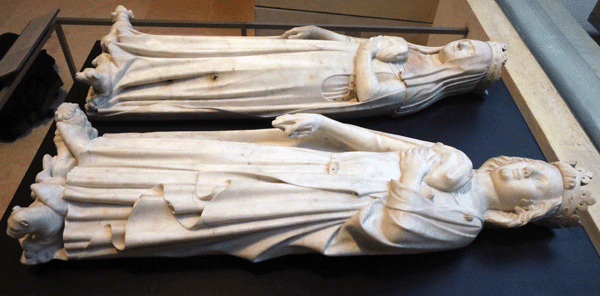 |
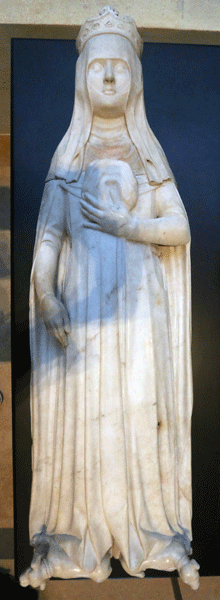 |
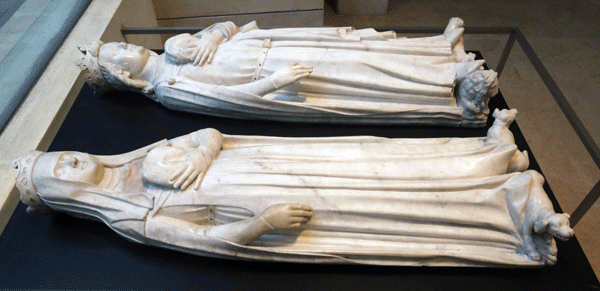 |
||
Charles IV (The Fair) (1328) & Jeanne d'Évreux (1371). The monument which covered their entrails burial. They are shown holding a representation of a leather bag which would have contained their entrails. Provenance: Abbaye Maubuisson, Saint-Ouen-l'Aumone, Val-d'Oise. The Queen had a particular attachment to the Abbey and requested that her entrails be buried there alongside those of her husband, who had died 43 year earlier. The monuments were commissioned by the Queen and executed by Jean de Liège (1372). Marble |
||
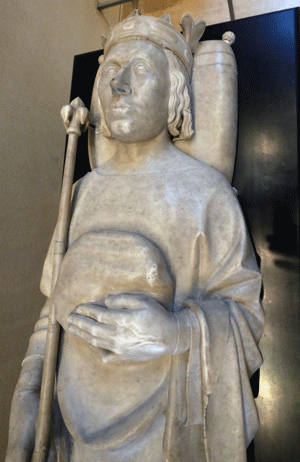 |
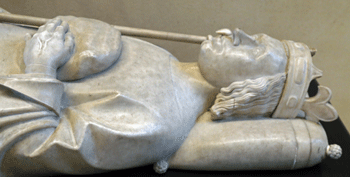 |
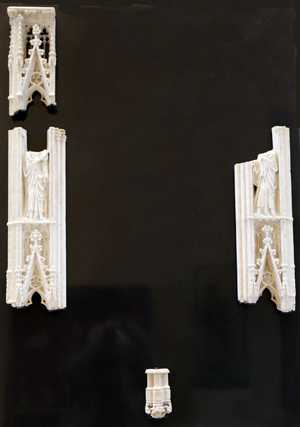 |
 |
||
| Charles V (The Wise) (1380) His entrails were buried under the above monument at the Abbaye de Maubuisson, near Paris, together with those of his wife Jeanne de Bourbon. Their bodies were buried at St Denis and their tombs surmounted by two effigies; however that of Jeanne was destroyed during the Revolution although that of Charles remained intact. When everything was repaired and restored, the entrails effigy was moved to St Denis to lie with that of Charles while the entrails effigy of Charles eventually came to the Louvre. On the far right are the remaining fragments of the St Denis tomb. Marble by Jean de Liège. | ||
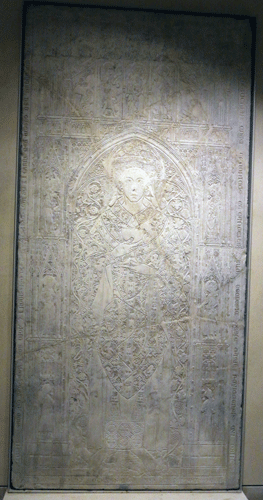 |
 |
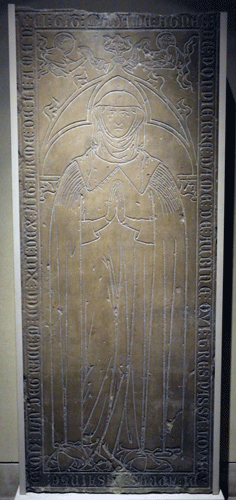 |
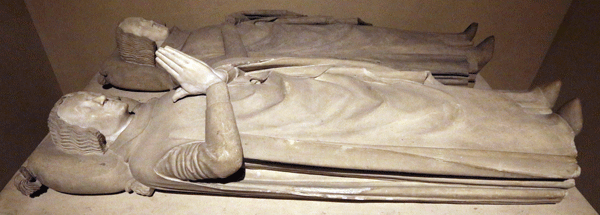 |
|
Above: Jean Casse (1350) Chancellor of
Noyen Cathedral. Limestone incised slab. Provenance:
Abbaye Sainte-Genevieve, Paris. Centre Top: Unknown lady (1340-1350) Limestone and alabaster with plaster repairs, mainly to the hands. The feet originally rested on lions but these were replaced by dogs, which are more usual on ladies' effigy, during restorations in the 19th century. The effigy is behind glass: hence the vertical line. Right: Heads (1360-1400) from the monument of Philippe III, Count of Évreux & King of Navarre (1349) & Jeanne de France (1349) |
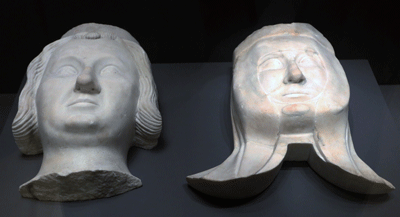 |
Above:
Agnès
de Dompierre,
Dame d'Aubiné. (1313). Incised slab
1300-25. Wife of Guillaume de Fontaine.
Provenance: Prieuré de Bouvaux, Daix, Côte d'Or, Burgundy Centre Bottom: Effigies of two brothers: Jean de Dormans (1380) who was a Canon of Paris and Chartres and Chancellor of Beauvais, and Renaud de Dormans (1386) who was Archdeacon of Châlons and Master of Requests for the king. The monument originally was that of three brothers. Limestone and marble Provenance: Chapelle du collège de Dormans dit de Beavais, Paris |
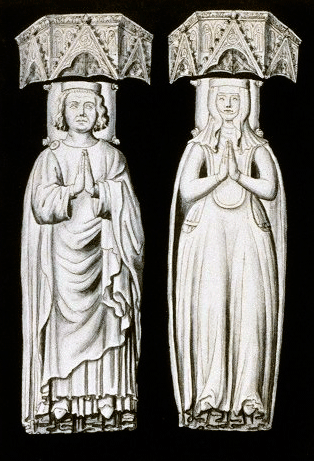 |
| Drawing of the effigies of Phillippe III & Jeanne, from above. Phillippe joined the crusade against the Muslims in the Iberian peninsula but was wounded by an arrow at the siege of Algeciras. The wound was fatal and his body was buried at Pamplona but his heart was returned to France and buried at the Couvent des Jacobins, Paris, This is the monument but note he is not holding a heart in this instance. |
 |
 |
| Unknown Child (1300-25) Thought to be a daughter of Charles IV. Provenance: Abbatiale de Pont aux Dames, near Paris | Guillaume de Chanac (1348) Bishop of Paris. Marble. Provenance: Chapelle de l'infirmerie de l'abbaye de Saint-Victor, Paris. |
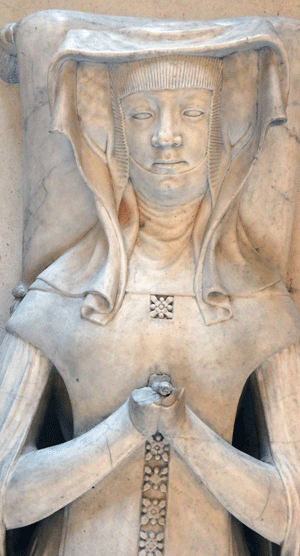
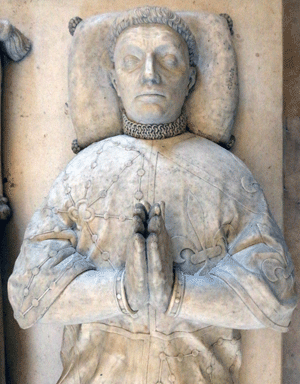
|
 |
 |
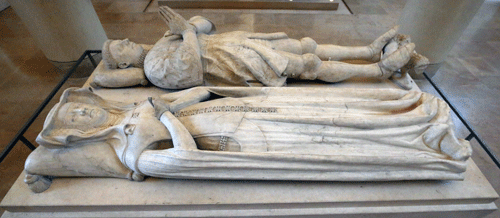  |
| Pierre d'Évreux-Navarre, Count of Mortain (1366-1412) and his wife Catherine d'Alençon ( -1462) White marble. Provenance: Église de la Charteuse, Paris. On Pierre's death, his wife commissioned the double tomb but she outlived him by fifty years and was buried with her second husband in the Église Sainte-Geneviève, Paris |
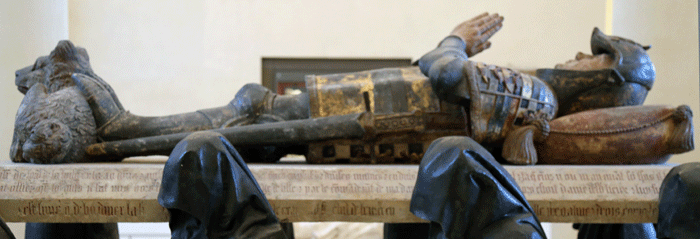 |
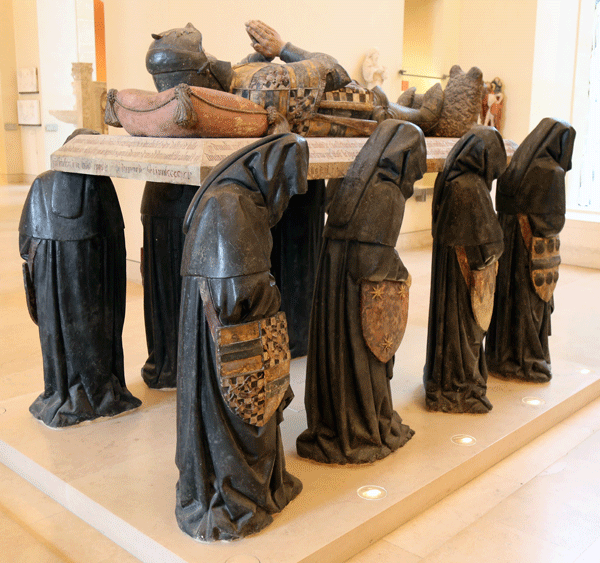 Above & Left: Philippe Pot (1428-1493) Grand Seneschal of Burgundy, then counselor to King Louis XI. Polychrome stone; he commissioned the monument in his lifetime. Provenance: Chapelle Saint-Jean-Baptiste de l'Abbaye de Cîteaux (Côte d'Or); demolished in Revolution. |
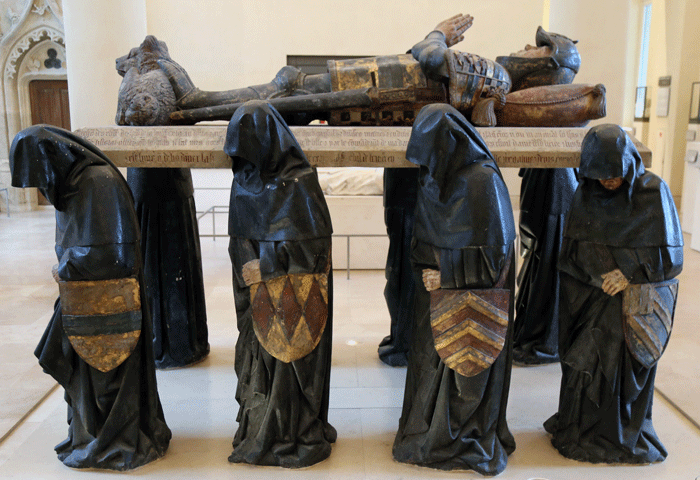 |
|
|
|||||||
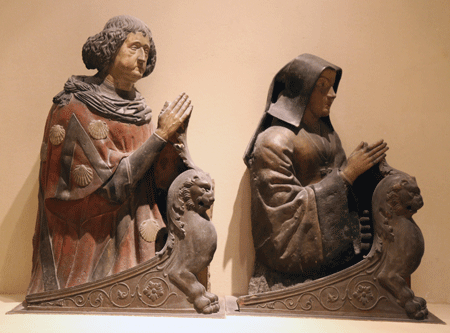  |
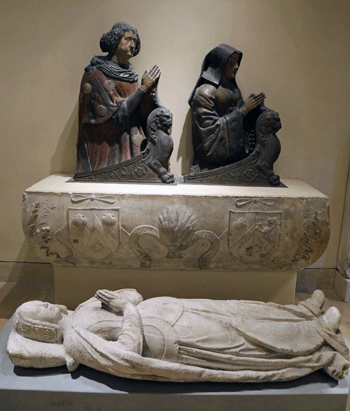 |
|
Above
& Left:
Philippe de Commynes
(1447-1511) and his wife
Hélène
[de Chambes] (1531) Stone with traces of polychrome and overpainting. Below is their sarcophagus; once polychrome. Below this is the effigy of their daughter, Jeanne (1514), wife of René de Bosse, Count of Penthievre. Alabaster, added later. Provenance: chapel he had founded in l'église des Grands-Augustins de Paris. |
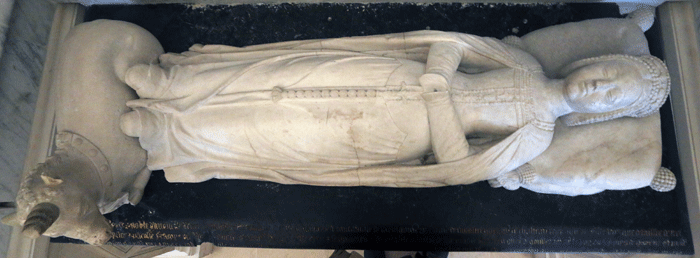 |
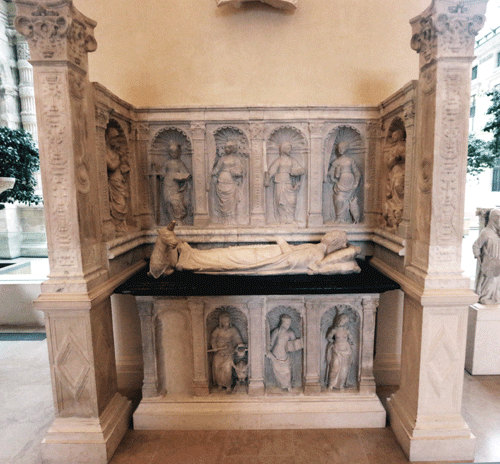 |
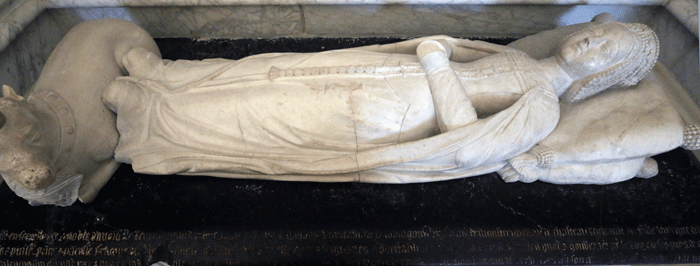 |
 |
|
Renée d'Orleans-Longueville (1508-1515). Daughter of Duke François II de Longueville. Provenance: Chapelle d'Orléans dans l'église des Célestins, Paris. Alabaster. Note the unicorn, a symbol of virginity: she is also surrounded by several female figures and above (not visible in the photograph) are two small angels supporting the arms of Queen Claude, wife of François I. |
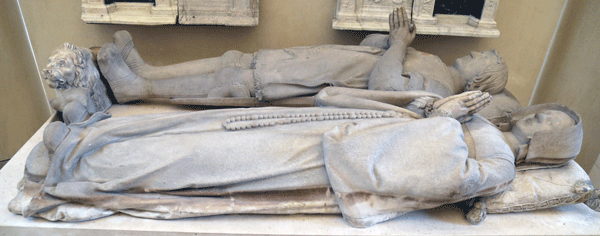 |
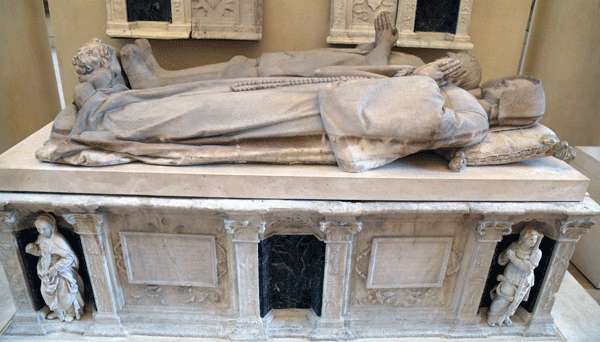 |
| Louis de Poucher (1521) & Robine Le Gendre (1520) Notary and secretary to Charles VIII and Treasurer of France. Alabaster and marble. Commissioned by his brother Etienne, Archbishop of Sens, from artists in Tours: Guillaume Regnault and Guillaume Chaleveau. The two figures in niches in the tomb chest represent Faith and Hope but Charity is missing. Provenance: La Chapelle Saint-Martin de l'église Saint-Germain-l'Auxerrois, Paris |
 |
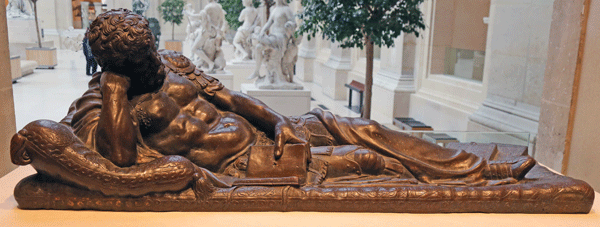 |
 |
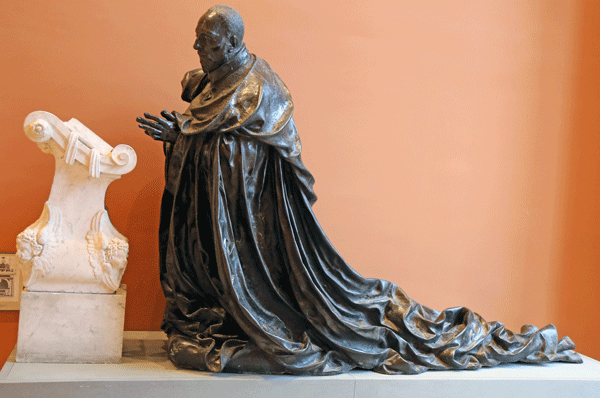 |
||
 |
| Above Left: Duke Henry I de
Longueville (1593) Heart burial. Marble, Stone
and Bronze by François Anguier.
Provenance: Chappelle des Orléans dans l'église des
Célestins, Paris. Also know as 'The Pyramid of the
Longuevilles' as it celebrates other members of the family. The
are bronze reliefs on each of the faces, including a bust of the
Duke and episodes from his life, such as the Battle of Senlis.
The four virtues - Prudence, Justice, Temperance and Fortitude -
are represented by Classical rather then Christian figures. Duke
Henry campaigned with the future Henry IV during the latter's
wars. He died of wounds following a salvo from a musket on his
triumphal entre into Douriiers, possibly assassinated. Above Centre Top: Albert-Pie de Savoise (1531) Count of Carpi. Frequently related to a sepulchral project commissioned by François I from his painter Rosso Florentino. It could however be related to the work of Gian Francesco Rustici in Paris Above Centre Middle: Cardinal René de Birague (1582) Bronze and marble by Germain Pilon. Provenance: la chapelle funéraire de Birage dans l'église Sainte-Catherine-du-Val-des-Écoliers, Paris.When that church was demolished in 1783 the tomb was dismantled and moved to Church of Saint-Louis-des-Jesuits. During the Revolution it was again dismantled and it is thanks to Lenoir that the bronze survived; the rest of the large monument was lost. Above Centre Bottom: André Blondel de Racquencourt (1558) by Jean Goujon. Commissioned by his widow. Controller General of France. The fixing holes in the metal can be clearly seen. Provenance: Couvert des Filles Repentés, Paris Above Right: Henry II (1559) Heart burial. Provenance: Église des Célestins, Paris. Henry died following an accident in a tournament and the monument was commissioned by his widow, Catherine of Médici. The three Graces with bare breasts carry an urn on their heads, which would have contained the heart of the King. By Germain Pilon and Domenico del Barbiere who constructed the triangular base and the bronze urn; however this was melted down during the Revolution and replaced by a gilded wooden one. |
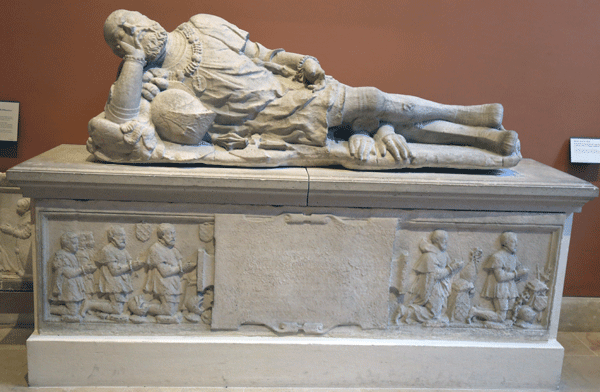 |
 |
 |
|
Above Top: Jean
III d'Humières
(1550). Alabaster by
Pierre Bontemps. Chamberlain to François
I; Lieutenant-General in Italy, Savoy and Piedmont. On the tomb
chest are represented in low relief his seven sons.
Provenance: l'église de Monchy-Lumières, Oise, Picardy.
His three daughters were represented in a similar manner on the
tomb of his wife: this panel can just be seen to the left. Above Bottom: Catherine of Médici (1589)This cadaver effigy was destined for the tomb of the Queen and Henry II at St Denis. However it was never completed either because of a decision by the Queen or the death of the sculptor. Marble by Girolamo Della Robbia. Right: Charles de Maigny (1556) By Pierre Bontemps. Captain of the king's guard. |
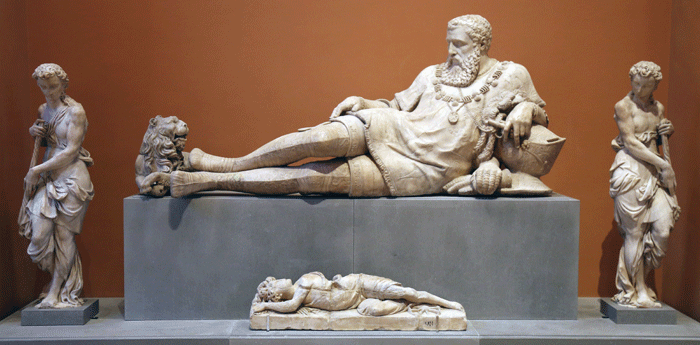 Above: Philippe Chabon, Count of Brion (1543) Admiral of France. The sculptor is unknown by some work may be by Jean Cousin and by Pierre Bontemps. Provenance: Église des Célestins de Paris Right: Valentine Balbiani (1572) Marble by Germain Pilon with collaboration by Matthieu Jacquet.. Wife of Réne de Birague, Chancellor of France. Provenance: Chapelle Birague in Église-Catherine-de-Val-des-Écoliers, Paris. Below is a drawing from the Gaigineres collection of the tomb before its partial destruction; it is of white marble, with some black and coloured marbles and bronze. Note the variation from the usual double cadaver tomb: Valentine is shown in the round reclining on the upper stage while at the base she is shown as a cadaver in bas relief. |
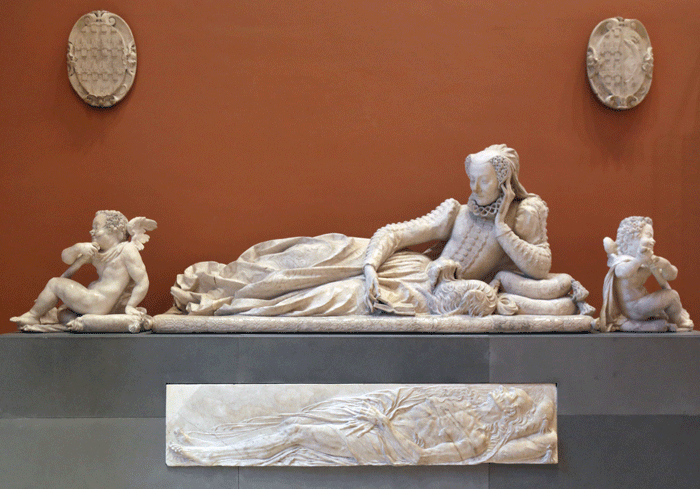 |
 |
 Left: Jean d'Alesse (1571) by Matthieu Jacquet. Provenance: Chapelle de Nom de Jésus in Église des Minimes de Passy. All the remains of the tomb that was destroyed in the Revolution is the bust. He was father of Saint François de Paule, founder of the Order of Minimes Above: A swaddled child from the tomb of the small children of the Duchess of Bouillon. Marble by Matthieu Jacquet (1577) Provenance: Église de Nogent-le-Roy Right: Guillaume Froelich (1563) Colonel Général des Suisse. Marble by Pierre Bontemps. Provenance: Église des Cordeliers, Paris |
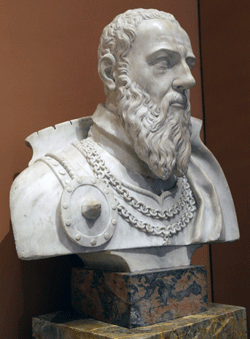 |
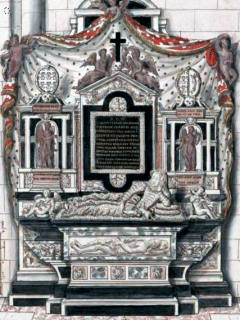 |
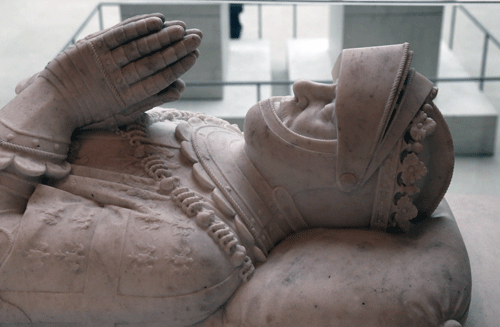   |
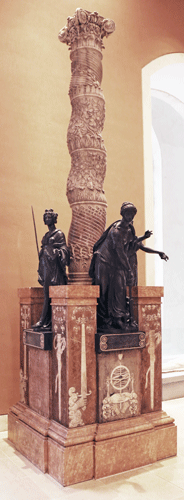 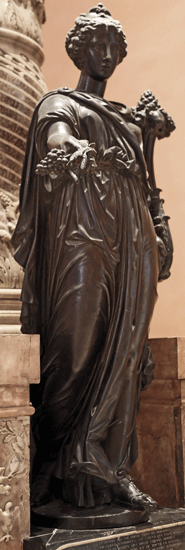 |
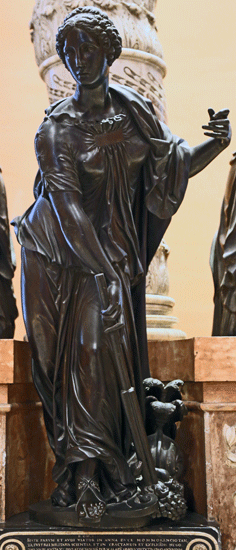 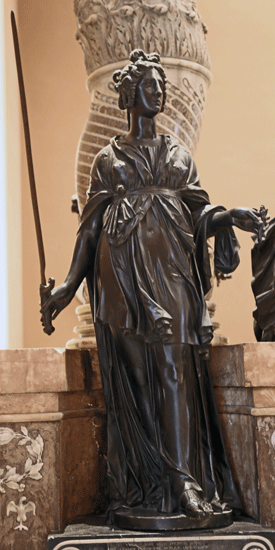 |
|
Above :
Anne de
Montmorency (1493-1567)
& Madeleine of
Savoie (1580) Constable of France. He died of wounds after leading the royalists to victory at the Battle of Saint-Denis. The monument was designed by Jean Bullant and executed by Berthélemy Prieur. Marble. Provenance: Collégiale Saint-Martin. Right: Heart burial monument again designed by Bullant and executed by Prieur, except the statue of Justice which was by Martin Leford. The base is of red marble with inlays of white marble and the twisted column of white and Campan marble (rose). This would have held a bronze urn containing the heart but this was melted down during the Revolution. Around the base are three bronze virtues: Justice, Peace and Abundance (also called Felicity). Provenance: Église des Célestins, Paris |
||
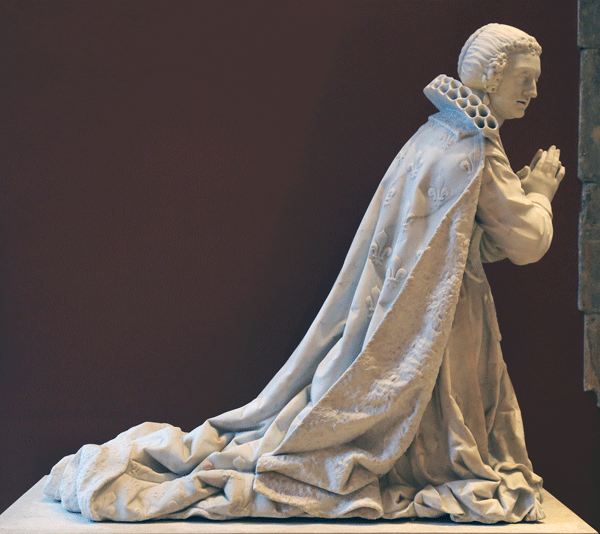 |
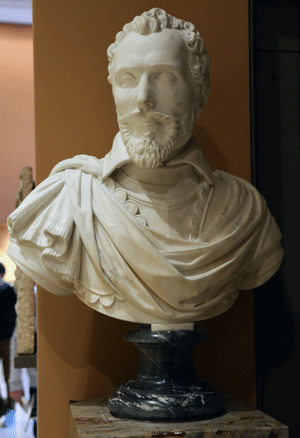 |
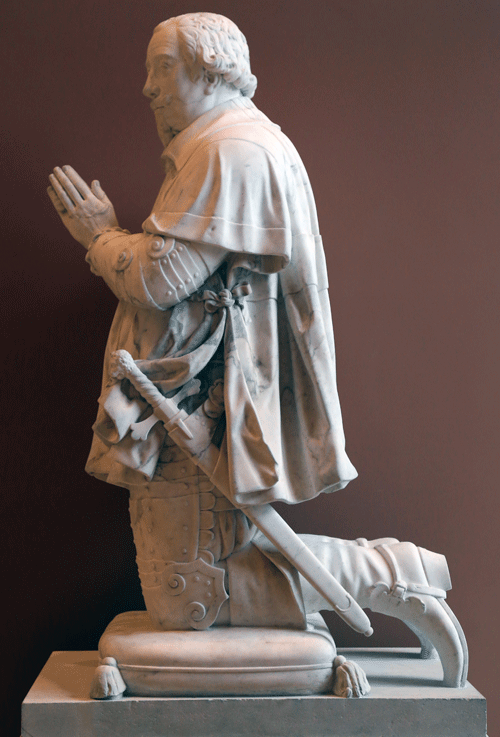 |
Left: Charlotte-Catherine de La Tremoville (1620) Princess of Conti. Marble by Simon Guillain. Provenance: Église religieuses de Sainte-Claire-de-l'Ave Maria, Paris. Above: Dominique de Vic, Viscount d'Ermenoville (1610) Vice-Admiral of France. Marble by Guillaume Dupré. From his cenotaph in Église d'Ermenonville Right: Amador de La Porte (1644) Marble by Michel II Bourdin. Grand Prior of the Order of Malta in France. Uncle of Cardinal Richelieu. Provenance Église de Temple, Paris |
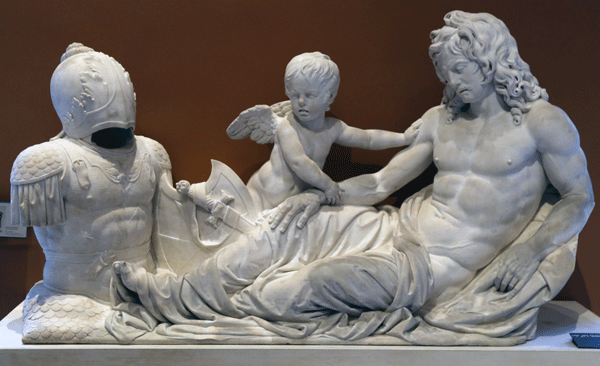 |
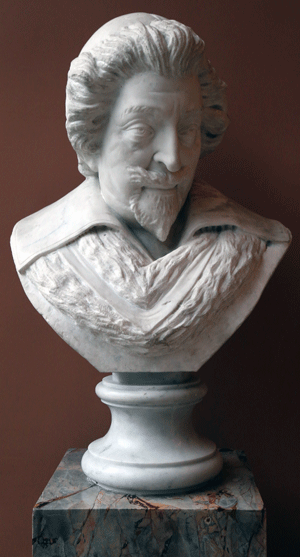 |
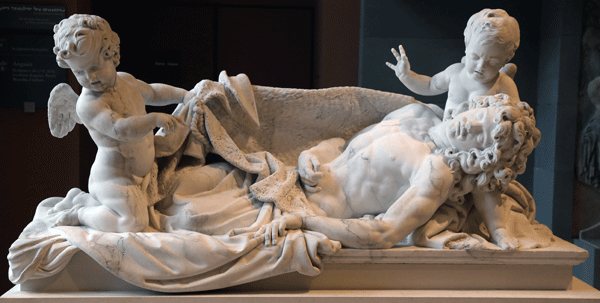 |
| Jacques de Souvré (1670) Marble by François Anguier. Provenance: Église de Temple, Paris | Nicholas le Jay (1640) Marble. Attrib: Pierre II Biard Provenance: L'église des Minimes, Paris |
Henry Chabot, Duke of Rohan
(1655)
Marble by François Anguier. Provenance: Chapelle d'Orléans a l'église des Célestins, Paris |
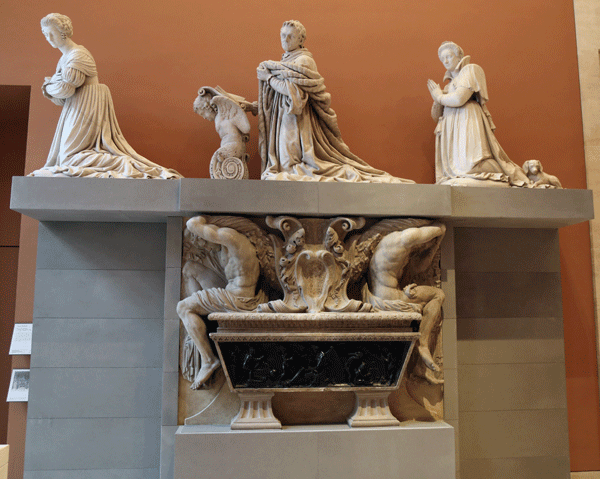 |
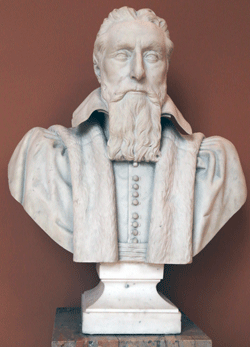 |
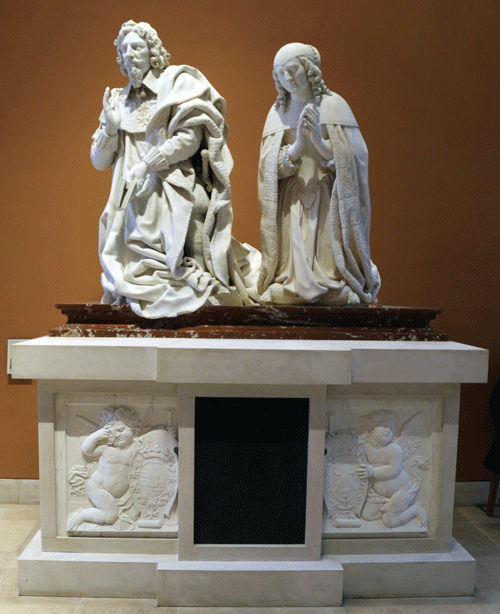 |
| Jacques-Auguste de Thou (1617) , historian and author kneels between his two wives, Gasparde de la Chatre (1617)and Marie de Barbançon (1601). Below on a sarcopagus sit Justice and Study. Marble by François Augier, except that of Marie which is by Bartholémy Prieur and in a more rigid style. These are the surviving figures from the monument. Provenance: the Thou Chapelle, Église de Saint-André-des-Arts | Guillaume du Vair (1621) Bishop of Lisieux and Keeper of the Seal. Provenance: La Chapelle du Collège des Bernardins, Paris. Only the bust remains Inspired by a portrait by Frans II Pourbus. a copy of which exists in the department of paintings. | Duke Charles de La Vieuville (1653) & Marie [Bouhier] (1663) Marble by Gilles Guérin 1658. Part of monument. Provenance: Chapelle Saint-François-de-Sales dans l'église des Minimes de la Place Royale, Paris |
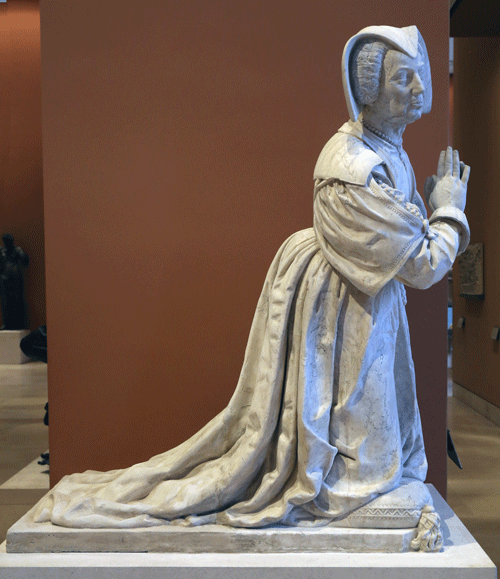 |
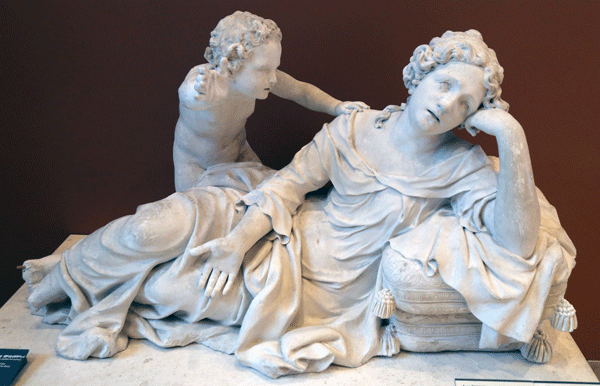 Marguerite Valon (1674) Stone by Jean Dubois. Commissioned by her husband Jacques de Mucie, President of the Burgundy Parliament. Provenance: Couvent des Minimes de Dijon. The sarcophagus was of marble and was reused in l'Église de Saint-Bénigue, Dijon, as a base for a praying statue. A sketch of the monument is preserved in the Dijon Museum |
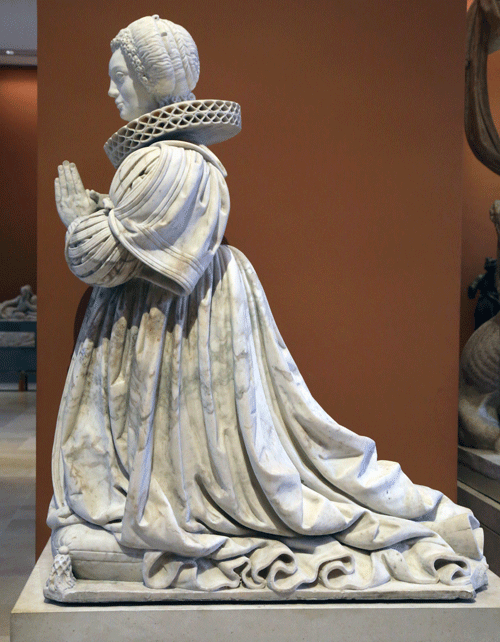 |
| Chértienne Leclerk (1627) Marble attrib: Simon Guillain. Provenance: Église des Carmes-Déchaussés de Charenton | Madeleine Marchand (1625) by Thomas Boudin. Commissioned by her husband Nicholas Le Jay, President of the Parliament of Paris, for l'Eglise de la Place Royale, Paris |
| References to the Sculptors | ||
| François Anguier. | French | c1604-1669 |
| Domenico del Barbiere | Italian | 1506-1570 |
| Pierre II Biard (or The Younger) | French | 1592-1661 |
| Pierre Bontemps | French | 1507-1568 |
| Jean Bullant | French | 1515-1578 |
| Michel II Bourdin. | French | 1609-1678 |
| Thomas Boudin | French | 1570-1637 |
| Guillaume Chaleveau. | French. No separate entry | |
| Jean Cousin | French | 1500-before 1593 |
| Guillaume Dupré. | French | 1576-1643 |
| Jean Dubois | French | 1625-1694 |
| Rosso Fiorentino | Italian | 1495-1540 |
| Simon Guillain | French | 1589-1658 |
| Jean Goujon. | French | c1510-1565 |
| Mattieu Jacquet | French | c1549-1611 |
| Martin Leford. | French. No separate entry | |
| Germain Pilon | French | c1527-1590 |
| Frans II Pourbus | Flemish | c1569-16222 |
| Berthélemy Prieur | French | c1563-1611 |
| Guillaume Regnault | French | c1450-1532 |
| Girolamo Della Robbia. | Italian | 1488-1566 |
| Gian Francesco Rustici | Italian | 1475-1554 |
| Jean Le Liège | Flemish, but mainly active in France | c1330-1381 |
| Guillaume de Veluten | French. No separate entry | |
| Please Note: The majority of the above links will take you to the English version of the sculptor's biography. Rather inexplicably a few names do not have English entries but only French ones, in which cases the link is to the English translation of the French entry; as these translations are sometimes a little stilted, I would advise those who have a reasonable understanding of French to consult the French entries. | ||
With alphabetical orders I have again been inconsistent. The sculptors appear to have definite surnames so I have put them in order of surnames but with their Christian name first so not following the French form. With the general index I have put the names in order of Christian names. Charles IV obvously comes before Charles V, even though (were we to be pedentic) logically the word fifth comes before fourth; their surname could be Capet or Valois. What do we do with Henry Chabot, Duke of Rohan: Chabot or Rohan? John the Fearless, Duke of Burgundy: clearly his name isn't Fearless nor Burgundy: it's actually Capet - or is it Valois? So let's keep to Christian names or it will read like War and Peace.
